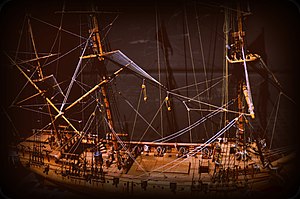Whydah Gally

model of Whydah
|
|
| History | |
|---|---|
|
|
|
| Name: | Whydah Gally |
| Namesake: | The African slave port Ouidah |
| Owner: | Sir Humphry Morice |
| Operator: | Private Vessel |
| Builder: | Unknown |
| Cost: | Unknown |
| Laid down: | 1715, London |
| Launched: | 1716, London |
| Homeport: | London |
| Fate: | Captured by pirates |
| Commander: | Captain Lawrence Prince |
| Chased by pirates: | late Feb, 1717 Windward Passage |
| Surrendered / Captured: |
three days later, near the lower Bahamas |
| History | |
|
|
|
| Name: | Whydah Gally |
| Owner: | Crew of Captain/Commodore Samuel "Black Sam" Bellamy |
| Acquired: | late February, 1717 |
| Homeport: | Blanco Islet, B.V.I. (later re-named Bellamy Cay) Caribbean Sea |
| Fate: | ran aground, capsized |
| Status: | Ruins under perpetual recovery and conservation; private ownership & exclusive dive rights |
| Commander: | Samuel "Black Sam" Bellamy |
| Wrecked: | late night of 26 April 1717, Wellfleet, Cape Cod, Massachusetts Bay Colony Coordinates: 41°53′31″N 69°57′34″W / 41.892°N 69.9594°W |
| Discovered: | 1984, by Barry Clifford |
| Authenticated: | 1985, by discovery of the ship's inscribed bell and a brass placard, both inscribed with ship's name |
| General characteristics | |
| Type: | Galley |
| Tons burthen: | 300 tons BM |
| Length: | 110 ft (34 m) |
| Propulsion: | Sail & oar |
| Sail plan: | fully rigged, 3 masts |
| Speed: | 13 knots (24 km/h; 15 mph) |
| Complement: | 150 men at launch; went down with 145 men & 1 boy (incl. 6 prisoners) |
| Armament: |
AT LAUNCH: 18 Active Guns PIRATE UPGRADE: 28 Active Guns RECOVERED: More than 65, recovery ongoing |
| Notes: | Whydah was the flagship of a 5-ship fleet which included the Marianne, Mary Anne, Anne, and Fisher. |
AT LAUNCH: 18 Active Guns PIRATE UPGRADE: 28 Active Guns
Whydah Gally (commonly known simply as Whydah or Whidah, and rarely, written as Whidaw, or Whido), pronounced "wi-duh", was a fully rigged galley ship that was originally built as a passenger, cargo, and slave ship. On the return leg of its maiden voyage of the triangle trade, it began a new role in the Golden Age of Piracy, when it was captured by the pirate Captain Samuel "Black Sam" Bellamy, and was refitted as his flagship. Immediately heading northward, Bellamy captured a few more ships along the coast of Colonial America, and was caught up in a storm which heavily damaged the Whydah and broke one of its masts. Patch-ups and repairs were effected until they reached the waters near Nantucket Sound, where greater repairs were effected, possibly at Block Island or Rhode Island.
Two months later, Whydah Gally headed east to open ocean and turned northward with a heading for Damarscove Island near Maine; but Bellamy ordered a course correction, taking the ship to the "elbow" of Cape Cod, and on 26 April 1717 they captured the ship Mary Anne with a hold full of Madeira wine. The captain of Mary Anne refused Bellamy's request to pilot them up the coast, so Bellamy arrested the captain and five of his crew and brought them aboard Whydah Gally, leaving three of the original crew aboard Mary Anne. Then Bellamy sent 7 of his own men onboard of Mary Anne - one of whom was the carpenter Thomas South who had been forced by Bellamy and his crew to make repairs; not wanting to join the pirate crew he had been offered release by Bellamy after work was completed, but the surviving pirates later testified to the court that they had over-ruled Bellamy's decision and forced South to stay due to his much whimpering and complaining. South testified that it was his choice to accompany the 6 pirates going aboard Mary Anne in hopes of escaping, possibly by jumping overboard and swimming ashore as they drew near to the Cape. Sometime around sunset that evening, the winds completely died, and a massive fog bank made visibility virtually nil. The four ships in Bellamy's fleet lost sight of one another. Bellamy's ships Anne and Fisher moved out to sea (eventually making it to Damascove Island with heavy damage).
Just after midnight, Whydah Gally was suddenly struck by an extremely powerful Nor'easter storm with the force of a Category-One hurricane. Running bow-first into a sandbar 16-feet deep at about 500 feet from the shore at what today is Marconi Beach of Wellfleet, she was battered by 30 to 40 feet waves. Within minutes the masts fell and the ship was pulled into 30 feet of water where she completely capsized, sending over 4.5 short tons (4.1 tonnes) of silver and gold, more than 60 cannons and 144 people to the ocean floor; with churning shoals and monstrous waves throwing many pieces of Whydah's shattered body, her rigging and sails, 102 human bodies, and thousands of objects across four miles of the beach. Mary Anne was also wrecked that night, ten miles south, being thrown by the waves on the beach at Pochet Island [pronounced po-chee]. Of the 146 souls aboard Whydah, only two men (Welshman Thomas Davis and 18-year-old Central American Mosquito [Moskito] Indian John Julian) are known to have made it to the beach alive; all seven of Bellamy's men and the three original crewmen from Mary Anne survived as well. Arrested by Justice Joseph Doane and his posse, they were all locked up in Barnstable Gaol (currently the oldest wooden jail house in United States), and then brought, by order of Governor Samuel Shute, to Boston for a nearly seven-month trial, after which six of the men would be executed by hanging, two set free, and one sold into slavery.
...
Wikipedia
